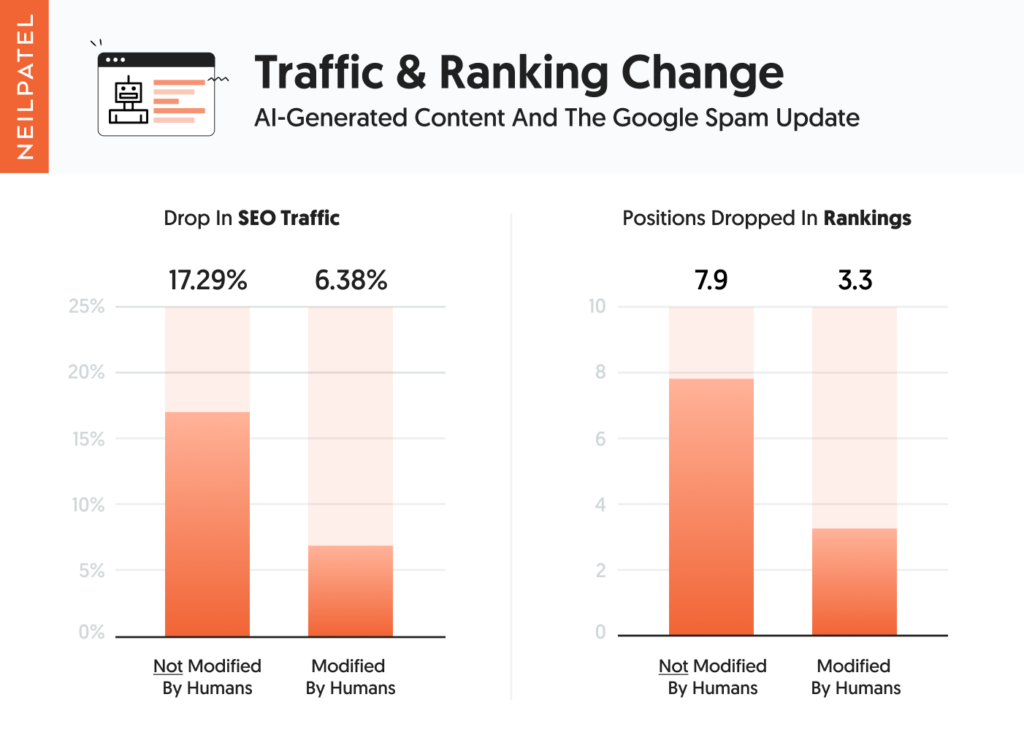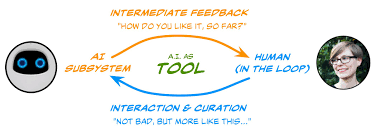Are Search Engines Penalizing AI-Created Content?

Up until the early 2000s, tricking Google by using tactics like keyword stuffing may have been commonplace, but the search engine runs a pretty tight ship now. In the recent ‘helpful content update’, Google has reiterated what most good SEOs have known all along: create valuable content with the user at the center. The ‘trick’ to ranking in SERPs is not about outsmarting Google, but about working with it to add genuine value and provide real answers to users.
And yet, today the internet is abuzz with just one question: can Google filter out AI content? And will you be penalized for creating AI-generated content? The answer is yes and no.
Why Yes?
Post the helpful content update, the truth is that some AI content has definitely been hit. In fact, Neil Patel did an experiment where he tested 2 websites after the ‘Helpful content’ update. The one that only had AI-written content saw traffic drop more than 63% than the control website where humans edited the generated content.

Reading the first blog, you can understand that even if you didn’t detect that the text was machine-written, it offers very little value to the reader. It’s a mish-mash of sentences with very low originality and almost no excitement factors.
John Mueller, Google’s Search Advocate, made no claims of Google being able to detect AI-written content but did say that completely AI-written content would come under the category of automatically generated content which is against the webmaster guidelines.
“For us, these would, essentially, still fall into the category of automatically generated content which is something we’ve had in the Webmaster Guidelines since almost the beginning.
And people have been automatically generating content in lots of different ways. And for us, if you’re using machine learning tools to generate your content, it’s essentially the same as if you’re just shuffling words around, looking up synonyms, or doing the translation tricks that people used to do. Those kind of things.
My suspicion is maybe the quality of content is a little bit better than the really old-school tools, but for us, it’s still automatically generated content, and that means it’s still against the Webmaster Guidelines. So we would consider that to be spam.”
Why No?
This begs the question: How accurately can Google detect AI-generated content? Mueller makes no such claim.
However, content that you generate using AI tools, without any intervention has a certain pattern of words that is easy to detect. Read “How does AI writing work?” to learn more about why this happens.
Short-text items are generally very human-like. But when combined, without human help will read odd to humans and usually offer no real information making the content very low-value.
This essentially means that AI-generated content that is thin and spammy, could very well be on Google’s radar. But if you’re being intelligent about using this powerful technology to create content that stands out – you will be okay.

How to do AI content well
Are you or your writers treating AI content as an arch-nemesis? Do you believe that AI will be the reason you may not have a job tomorrow? If yes, then you’re probably going to deprive yourself of some of its amazing capabilities – capabilities to help you do your job better. Or at least make parts of your job easier to do.
It’s not Human vs AI but Human with AI
AI writing has become crazy with the barrage of tools offering to write your blog post for you. Analyzing Peppertype.ai’s 800mn generations across 65+ content types, we found that it’s great at
- Being an idea-brainstorming partner
- Expounding or simplifying sections of text
- Providing variations of content within seconds
- Short form text

While struggling with
- Writing coherent content of more than 100 words without supervision
- Producing factually accurate data
- Narrowing down from a set of variations to pick the best one
Embracing AI to create content can help you:
- Create content at scale
- Automate tedious tasks and save time
- Generate personalized content
- Automatically suggest new topics, titles, and structures for content
A human-in-the-loop approach
We’ve now established that AI isn’t quite ready to take the driver’s seat, but it can be a superpower if used correctly. The quality of content created is great and very readable. In fact, Peppertype.ai data shows us that with the right nudges, AI+human content creation can decrease as much as 60% of the time spent writing content.
The approach that works well with AI writing that engages readers, doesn’t attract negative penalties on Google, and helps positively in SEO is a human-in-the-loop approach.
To summarise this well through an image from stanford.edu, the approach is meant to be a constant feedback system to the AI making the net output a lot better, while making the AI smarter over time.

Don’t let AI control the flow of writing
Create an outline and use AI generations to help fill in the blanks. In our flow, we constantly used AI to help us complete a paragraph or expand on a section we hadn’t written enough on.
Use AI for live brainstorming
Since you can create unlimited variations of content and ideas, AI makes for a great brainstorming buddy to find new chains of thought. Feel free to keep generating new content again and again till you find the right path forward.
Beware of ‘AI hallucinations’
AI generally falters or wanders off (also called AI hallucinations) when you let it keep writing a lot of content. It’s generally a good idea to generate 50-100 words before stepping in and nudging it in the right direction.
Add ‘excitement factors’ to AI-generated content
Humans are great at research, finding unique points of view, and keeping content fresh. When a piece of content is written, we like to go through it again and add proof points, anecdotes, and perspectives that make the content original. Some examples of excitement factors are:
- Data. A reader is 52% more likely to engage with facts and data than just words.
- An anecdote. Stories have been known to engage users, and short crisp anecdotes are great to draw in a user. Look at how _ embeds stories within their blogs.
- Visuals. Images go a long way to keep readers interested, but the age of stock images is coming to a close. Images connected to the content work great. We’ve used hand-drawn illustrations for this post.
The best part about this approach is that AI can constantly learn from the adjustments you make and every new sentence will be better than the last. If you’re using a technology that remembers personal preferences and can fine-tune models specific to your account, you might end up with an intern you’ve trained to understand the content you prefer.
Use AI as an enabler and not a replacement
AI tools today have created a lot of hype among themselves, which forces them to make bold claims of being able to replace the human thought process. This reputation is very hard to live by and users generally leave feeling disappointed.
Taking a more pragmatic approach of using these AI tools as assistants to your writing process will save you a lot of heartburn, besides giving you 3 superpowers
- It’ll take you 60-70% less time to create content. You won’t encounter writer’s block that often, you don’t necessarily need to write all the content yourself and you can rephrase paragraphs within seconds (saving you valuable editing time as well).
- Content created by Humans + AI is usually very high quality and reads well. Since your writing will now have both breadth and depth, it will rank higher on Google and be liked by your readers.
- You’ll struggle less with juggling approaches. While obvious, this can be a big advantage as you don’t spend as much time evaluating different tools and approaches to find the perfect one. There’s so much content out there about AI writing that sometimes getting started is the hardest part.
So what’s a content marketer to do? TL;DR
There’s a LOT going on in the content creation space today and a lot of might feel lost in the maze of developments. Here’s our set of top 6 takeaways for you.
- AI content is here and it can be a useful tool in your content arsenal. If you’re not using it today, start experimenting as it can reduce over 60% time in creating original content.
- Google wants you to create expert, original, in-depth, and helpful content that satisfies your readers.
- You want people to spend more time on your content. Use excitement factors to differentiate your content from the rest.
- Google doesn’t automatically detect AI-written content today, but human editing on top of AI content performs over 50% better on search rankings and traffic.
- Use a human-in-the-loop approach to content creation with AI by nudging AI to write short pieces of content, brainstorm alongside you, and train it to get better over time.
- Don’t get caught in trying to find the perfect approach. Get started and figure it out as the overall technology landscape evolves with you.
While technology and AI may have long been perceived as the enemy, we believe that the times, they are a-changin’. It may well be time to embrace AI as that helping hand on your one-man content army, or your secret superpower to help you scale content in a way you never thought was possible.
Much like the parable of the six blind men and the elephant, AI will only be able to take you so far. Going beyond the trunk and the tail and visualizing an elephant, well, that will still be our job.
Latest Blogs
Explore how Google’s 2025 AI search updates triggered ranking chaos. Learn actionable strategies to adapt your SEO for AI Overviews, zero-click searches, and SERP volatility. Stay ahead now.
Learn how to rank on AI search engines like ChatGPT, Perplexity, and Gemini by optimizing your content for authority, structure, and relevance. Stay ahead in AI-driven search with this strategic guide.
Explore the best healthcare SEO services for your medical practice. Improve online visibility and effectively reach more patients in need of your services.
Get your hands on the latest news!
Similar Posts

Product
6 mins read
Elevate Your Content Strategy: The Value Proposition of Content Marketplace Platforms

Product
5 mins read
Achieving Seamless Content Marketing Platform Integration With Marketing Tools

Product
6 mins read